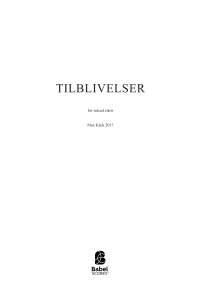Recherche avancée
within the Hadal and Epi
but, who has come back from there to tell us, if it's beautiful or not? “
revised 2022, New York
ISMN : 979-0-2325-6467-8
- Identifiez-vous pour créer une liste
This piece is inspired and based on one hand by the sculpture by Richard Serra (“The matter of time”) and how we perceive the progression in time while walking inside these gigantic spheres and on the other hand by the life and conditions within the deep sea; lack of light and extreme amount of pressure. In other words, the piece is happening between the Hadal and Epi zone…
“… In the huge sculpture by Richard Serra, Toruses and spheres are unexpectedly transformed as the visitor walks through and around them, creating an unforgettable, dizzying feeling of space in motion. The entire room is part of the sculptural field. As he has done in other sculptures composed of many pieces, the artist has arranged the works deliberately in order to move the viewer through them and through the space surrounding them. The layout of the works along the gallery creates corridors with different, always unexpected proportions (wide, narrow, long, compressed, high, low). The installation also includes a progression in time. On the one hand, there is the chronological time that it takes to walk through and observe it from beginning to end. On the other, there is the time during which the viewer experiences the fragments of visual and physical memory, which are combined and re-experienced…”
In the last years in connection with the Oceanography Institute Scripps in San Diego, I have been studying deep sea. What fascinated me the most, was the extreme conditions of life and the amount of pressure in the deep sea in the Hadal zone. ( A zone that human beings have not yet been able to enter fully)
“The Hadal zone, also known as the hadopelagic zone, is the deepest region of the ocean lying within ocean trenches. The hadal zone is found from a depth of around 6,000 to 11,000 meters (20,000 to 36,000 ft) to the bottom of the ocean. Most life at this depth is sustained by marine snow or the chemical reactions around thermal vents, and by metabolization of hydrogen and methane released by rock and seawater reactions. The low nutrient level, extreme pressure, and lack of sunlight create hostile living conditions in which few species are able to exist.
The hadal zone can reach far below 6,000 m (20,000 ft) deep; the deepest known extends to 10,911 m (35,797 ft). At such depths, the pressure in the hadal zone exceeds 1,100 standard atmospheres (110 MPa; 16,000 psi).”
The surface layer of the ocean is known as the epipelagic zone (Epi) and extends from the surface to 200 meters (656 feet). It is also known as the sunlight zone because this is where most of the visible light exists.
Conditions differ deeper in the water column such that as pressure increases with depth, the temperature drops and less light penetrates. Depending on the depth, the water column, rather like the Earth's atmosphere, may be divided into different layers.
Pages - 34








